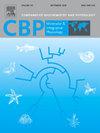Born in complexity: How the early life environment shapes zebrafish larvae phenotype
IF 2.2
3区 生物学
Q4 BIOCHEMISTRY & MOLECULAR BIOLOGY
Comparative Biochemistry and Physiology A-Molecular & Integrative Physiology
Pub Date : 2025-09-16
DOI:10.1016/j.cbpa.2025.111930
引用次数: 0
Abstract
The biotic and abiotic environments are potent drivers of individual plasticity. Zebrafish, a popular research model around the world, has been extensively used for understanding the proximate cause and mechanisms of phenotypic plasticity to environmental enrichment. Despite awareness of providing high-standard rearing condition for increasing fish welfare, rearing of zebrafish larvae involves little more than stable temperature and daily water changes. We asked whether including Lego bricks as additional visual and mechanosensory stimuli during early rearing would induce developmental plasticity across morphological (growth, forebrain cell proliferation), physiological (stress response), and behavioural (anxiety, habituation) endpoints. We raised zebrafish in Petri dishes with complexity (Lego bricks) from fertilization to 5 days post-fertilization (dpf) and then compared phenotypes to those of traditionally reared larvae (barren). Relative to barren-reared larvae, those raised with complexity were shorter and did not increase whole body cortisol in response to an acute agitation stressor. Forebrain cell proliferation was not different between treatments, however, larvae raised with complexity habituated sooner to an adverse stimulus and showed a tendency towards reduced anxiety-like behaviour, suggesting the anxiolytic effects of environmental enrichment may be initiated at early life stages. Taken together, our results invite consideration into how current practices in raising zebrafish may influence neurodevelopment and behavioural research findings, and may be applied to improve outcomes in fish breeding programs for conservation initiatives.

出生在复杂:早期生活环境如何塑造斑马鱼幼虫表型。
生物和非生物环境是个体可塑性的有力驱动因素。斑马鱼是一种在世界范围内流行的研究模型,被广泛用于了解环境富集的表型可塑性的近因和机制。尽管人们意识到为提高鱼类福利提供高标准的饲养条件,但斑马鱼幼鱼的饲养只需要稳定的温度和每天的换水。我们询问,在早期抚养过程中,将乐高积木作为额外的视觉和机械感官刺激是否会诱导形态(生长、前脑细胞增殖)、生理(应激反应)和行为(焦虑、习惯化)端点的发育可塑性。我们将斑马鱼置于复杂的培养皿(乐高积木)中,从受精到受精后5 天(dpf),然后将其表型与传统饲养的幼虫(不孕)进行比较。相对于不育饲养的幼虫,复杂饲养的幼虫更矮,并且在急性激动应激源的反应中不会增加全身皮质醇。不同处理的前脑细胞增殖没有差异,然而,复杂性饲养的幼虫更容易适应不利刺激,并表现出减少焦虑样行为的趋势,这表明环境富集的焦虑效应可能在生命早期就开始了。综上所述,我们的研究结果引起了人们对当前饲养斑马鱼的做法如何影响神经发育和行为研究结果的思考,并可能应用于改善鱼类繁殖计划的保护计划。
本文章由计算机程序翻译,如有差异,请以英文原文为准。
求助全文
约1分钟内获得全文
求助全文
来源期刊
CiteScore
5.00
自引率
4.30%
发文量
155
审稿时长
3 months
期刊介绍:
Part A: Molecular & Integrative Physiology of Comparative Biochemistry and Physiology. This journal covers molecular, cellular, integrative, and ecological physiology. Topics include bioenergetics, circulation, development, excretion, ion regulation, endocrinology, neurobiology, nutrition, respiration, and thermal biology. Study on regulatory mechanisms at any level of organization such as signal transduction and cellular interaction and control of behavior are also published.

 求助内容:
求助内容: 应助结果提醒方式:
应助结果提醒方式:


